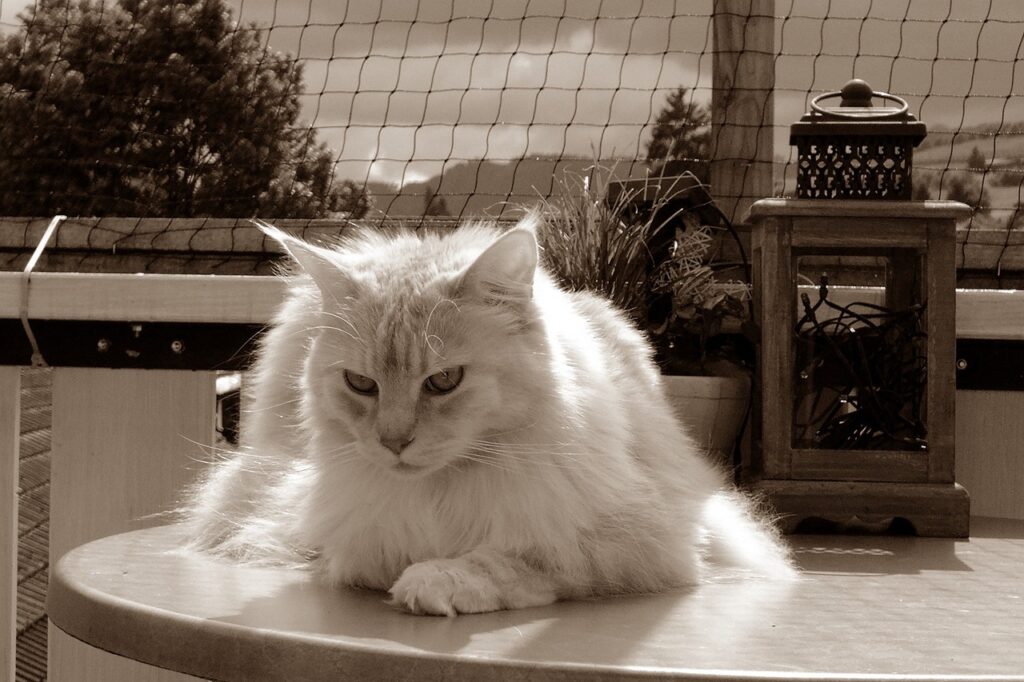Heat lamps may seem like an easy solution for cat owners looking to provide extra warmth for their feline friends. But are Heat Lamps safe for Cats? Let’s weigh the potential benefits against the risks to help decide if heat lamps are the right heating choice for your cat.
Are Heat Lamps Safe for Cats?

Hey there, fellow cat lovers! Are heat lamps safe for Cats? We’ve got your back. The good news is that yes, you can use heat lamps with your cats and keep them safe. Just remember a couple of important things.
Usually, people use heat lamps to keep outdoor cats warm or to give cozy vibes to dogs in their special homes. But guess what? You can use them indoors, too!
So, in this blog post, we will talk about some super easy tips to ensure your cat and the heat lamp become best buddies. And we’ll also chat about all the awesome things that happen when your cat gets to chill in a warm and toasty spot. Ready? Let’s dive in!
Table of Contents
What Are Heat Lamps?

A heat lamp emits light and heat as an incandescent or ceramic infrared heat bulb. The most common use for a heat lamp is to keep pets and their environments warm. Reptiles and birds often require supplemental heat sources, so heat lamps are commonly used in vivariums, terrariums, and aviaries.
Heat lamps come in a range of wattages, from 25 watts up to 250 watts. The higher the wattage, the more heat is emitted. Heat lamps screw into regular light bulb sockets and must be used with appropriate fixtures that are rated for the wattage of the bulb. The bulbs get extremely hot, posing a burn risk if touched or knocked over.
Many heat lamps are designed to focus heat in a fairly narrow beam. Others have a wider heat spread. There are also ceramic infrared heat emitters that warm but do not visibly glow. For safety reasons, heat lamps should always be used with a protective cage or guard and placed out of reach.
Why Would a Cat Need a Heat Lamp?
There are a few reasons cat owners might want to provide a heat lamp for their kitties:
- Warming cold areas of the home. Some rooms or areas of a home can feel chilly, like basements, garages, or areas near drafty windows and doors. A heat lamp can help warm up a cat’s favourite napping spot in colder areas.
- Supplemental warmth for elderly or sick cats. Senior cats or cats with medical conditions that make it harder to regulate their body temperature may benefit from a heat lamp to stay cozy.
- Warmth for newly adopted stray or feral cats. Cats used to living outdoors will need time to adjust to living inside a climate-controlled home. A heat lamp can help them warm up and feel comfortable in their new environment.
- Extra warmth for newborn kittens. Very young kittens have difficulty regulating their body heat. Providing a heat source can help keep kittens warm and thriving.
- Dry and warm newly bathed cats. After a bath, cats often appreciate extra warmth to help them dry off and increase their body temperature.
- Promote healing. The gentle warmth from a heat lamp can help soothe cats recovering from injuries or surgery.
So, in the right circumstances, a heat lamp can be a helpful way to provide cats with supplemental warmth. But misuse of heat lamps also comes with some risks.
The Pros and Cons of Using Heat Lamps for Cats
Advantages of Heat Lamps
Supplementing Natural Heat
Cats love basking in warm, sunny spots around the house. A heat lamp can mimic the natural heat and light from the sun that our domesticated cats would otherwise seek out. A heat lamp’s radiant warmth allows cats to lounge and sleep comfortably within the beam. For cats that are elderly, sick, or very young and need assistance in maintaining their body temperature, this guidance can offer valuable support.
Therapeutic Benefits
Gentle heat from a lamp may provide therapeutic relief for cats suffering from certain conditions. The warmth can help loosen stiff joints or soothe sore muscles in cats with arthritis. Heat lamps are sometimes recommended for cats recovering from injuries or surgery to stimulate healing. Always consult your vet before using a heat lamp therapeutically.
Potential Risks and Concerns
Burns and Overheating
One of the biggest worries with heat lamps is that they can cause severe burns if a cat directly touches the hot bulb. Curious cats may also accidentally knock the lamp over and get burned. Improper heights or unmonitored use increases the risk of burns or dangerous overheating.
Fire Hazard
Heat lamps reach high temperatures, making them a fire hazard if placed too close to anything flammable. Knocking the lamp into bedding or curtains could spark a fire. Defective wiring can also lead to overloaded circuits and potential fires.
Creating a Safe Environment with Heat Lamps
To minimize risks when using a heat lamp around cats, follow these safety tips:
Choosing the Right Heat Lamp
Quality and Safety Certifications
Opt for heat lamps made specifically for pet and veterinary use. Choose brands that meet quality standards and safety certifications to ensure effective temperature control.
Adjustable Settings
Look for lamps with adjustable heat output or dimmer switches. You can discover the ideal low-temperature setting to keep your cat warm and comfortable without risking overheating.
Placement and Installation
Height and Distance
Position the lamp at least 3-4 feet above where your cat rests, plays, or walks around. To avoid accidental contact with the heated bulb, ensure secure suspension using chains or cables that are out of the reach of your cats.
Securing Cords
Prevent tripping and chewing hazards by neatly securing all electrical cords to overhead beams or walls. Use cord covers or wraps to enclose the entire length fully.
Let’s now dive into more specifics on safely using heat lamps around felines.
Choosing the Right Heat Lamp for Cats
Not all heat lamps are created equal when it comes to pet safety. Here are the key features to look for when selecting one for cat use:
- Low wattage – For cats, aim for lower wattage bulbs, around 25-60 watts, to prevent intense overheating. Higher wattages like 250W are unnecessary and unsafe.
- Ceramic infrared bulbs – These heat but don’t visibly glow, reducing glare. However, they still produce high heat, so they need proper guarding.
- Adjustable brightness or warmth – Lamps that allow you to customize heat output are ideal to prevent overheating.
- Safety certification – Verify the lamp meets standards for electrical safety. Products designed explicitly for pets are best.
- Protective cage or shroud – The bulb should be fully enclosed in a wire mesh or perforated metal guard.
- Stable mounting parts – Sturdy chains, cables, and adjustable mounts keep the lamp securely positioned.
- High-quality wiring – Ensure the fixture uses adequate gauge electrical wiring to handle the wattage.
- Tip-over auto shut-off – In some cases, heat lamps have sensors designed to switch off automatically if they’re accidentally knocked over. This safety feature effectively reduces the risk of burns or potential fires.
The optimal heat lamp for cats will produce gentle ambient warmth while being extremely safe. Invest in a stable, adjustable lamp for pet use rather than improvising with dangerous high-wattage human heat lamps.
Ideal Placement and Positioning
Where and how you set up the heat lamp matters as much as the lamp itself. Follow these guidelines for the safest placement:
- Mount at least 3-4 feet above the floor so cats cannot reach it.
- Place the beam over lounging areas, but avoid confining cats inside it.
- Allow at least 3 feet of clearance on all sides from combustibles.
- Use secure chains or cables to fasten sturdily on the ceiling or high on walls.
- Avoid positioning near drapes, blinds, blankets, or other flammable objects that could blow into the lamp.
- Set away from high-traffic areas or busy cat play zones to prevent accidental impact.
- Angle the beam downwards so cats don’t stare directly into the light.
The lamp should heat the environment without cats having direct access. Give them room to move freely in and out of the warmth as desired.
Routines and Duration of Use
While heat lamps provide localized warmth, you do not need them running continuously like a household thermostat. Follow these usage tips:
- Only use for short durations while monitoring, not all day or overnight.
- Allow cats to come and go from the beam freely. Never trap or confine them in it.
- Alternate between the heat source and other resting areas so cats don’t overheat.
- Avoid using when cats are sleepy or unable to move away independently.
- Turn off and unplug when not in use to avoid accidental tip-overs.
The heat lamp should supplement the ambient temperature as needed. But cats still need full access to cooler, shaded areas to regulate their body heat as desired.
Signs of Overheating
Whenever using heat lamps around cats, stay alert for any signs of overheating:
- Heavy panting
- Salivating or drooling
- Seeking cool floors to lay on
- Reddened or warm ears/paws
- Rapid heartbeat
- Disorientation or incoordination
- Excessive meowing or crying
- Collapsing or difficulty standing
If you notice these symptoms, immediately turn off and remove the heat lamp. Apply cool water compresses and contact your vet promptly. Overheating can quickly become life-threatening without urgent treatment.
Prevent overheating by double-checking the lamp positioning, using lower settings, and supervising all usage. If one cat seems bothered by the heat while another still shivers, provide warming beds the sensitive cat can access out of the beam.
Safety Precautions and Maintenance
To use heat lamps safely and prevent hazards:
- Check wiring connections monthly and replace damaged cords.
- Keep the bulb free of dust, grease, or dead insects over time.
- Ensure ceiling/wall mounting remains secure and stable.
- Examine the guard cage periodically and replace it if it is cracked or bent.
- Always unplug when adjusting position, bulbs, reflectors, or guards.
- Use a thermometer to verify ambient temperatures stay moderate.
- Keep a fire extinguisher and emergency numbers handy, just in case.
Proper setup and precautions allow heat lamps to warm specific cat lounging areas as needed. But misuse comes with serious risks, so weigh the pros and cons before incorporating heat lamps into your cat’s environment.
Vet Consultation Recommended
As with any significant pet care decision, consult your veterinarian before using a heat lamp for your cat. Provide details on your specific lamp, intended usage, and cat’s health status. Your vet can advise if heat supplementation is appropriate and offer additional precautions tailored to your cat. Open communication will help ensure heat lamps improve rather than harm your cat’s quality of life.
Safer Heating Alternatives for Cats
Instead of using an open-bulb heat lamp, try these safer ways to provide soothing warmth for feline companions:
Heated Cat Beds
Enclosed electric heating pads and heated cat beds only reach mild temperatures to prevent burns. They allow cats to snuggle up comfortably without exposure to harsh, direct heat.
Self-Warming Pet Mats
Self-warming mats contain special inserts that reflect cats’ natural body heat at them. This allows the mat to maintain a low-level warmth without electricity.
Heating Pads Under Beds
Place flat electric heating pads under cat beds, padding, or fleece blankets on the lowest setting. Avoid pads without thermostats that could overheat.
Window Perches
Placing cozy beds near sunny windows allows cats to soak up free ambient warmth from the sun’s rays.
Space Heaters
Some small space heaters for indoor pets have protective grilles and auto shut-off if tipped over. However, supervision is still required.
Insulated Shelves or Hiding Boxes
Insulated sleeping nooks retain cats’ natural body heat efficiently once warmed up. Offering enclosed hideaways appeals to cats’ instincts.
With some creative thinking, you can find safer ways to provide your cat with warmth that minimize the risks of open-bulb heat lamps.
Conclusion
Heat lamps can provide cats with soothing, targeted warmth. But the risks of burns, overheating, and fire mean a safe setup is essential. Thoroughly research proper positioning. Choose low-wattage adjustable lamps designed for pets. Routinely monitor cats and ambient temperatures during use. With cautious use under supervision, heat lamps may offer some benefits. But alternative heating solutions are generally the safest options to warm your cat’s favorite lounging spots. Consider all factors and discuss with your vet whether heat lamps are appropriate for your unique cat.
FAQS: Heat Lamps for Cats
Are heat lamps designed for people safe to use for pets?
Heat lamps for human use can get extremely hot and are not adjustable, so they should not be used around pets. Purchase heat bulbs specifically marketed as being safe for pets/animals instead.
How close should a cat heat lamp be placed?
Heat lamps should be positioned at least 3-4 feet above where cats rest or move around for safety. It prevents accidental contact and minimizes overheating risk.
Can heat lamps be left on overnight for cats?
It’s recommended always to turn heat lamps off when unattended and not leave them on overnight. Unattended heat lamps pose burns, fires, or overheating risks if cats cannot move away from the heat source.
Do cat heating pads get hot enough to burn cats?
Quality-regulated heating pads designed for pet use only reach warm, not hot, temperatures to prevent burns. Avoid cheap, unregulated heating pads that lack safeguards against overheating.
Should I get a 25W or 50W bulb for cat heat lamps?
For cats, lower wattages around 25-50W are safer than higher wattage bulbs over 75W. The lower heat helps prevent accidental burns or overheating while providing soothing ambient warmth.
Can I use a ceramic heat emitter bulb all night for cats?
It’s generally not recommended. While ceramic bulbs produce less light, they still pose a burn and fire hazard if left unattended overnight. Use intermittently and monitor cats closely whenever the heat source is on.
Is using heat lamps to dry my cat after a bath okay?
A heat lamp can help safely dry a damp cat after bathing. But only briefly while directly supervising. Watch for signs of overheating and provide a way for your cat to move in and out of the heat beam.
How do I know if a heat lamp is too hot for my cat?
Watch your cat’s behavior closely whenever using a heat lamp. If cats seem distressed, try to move away, or express signs of overheating like excessive panting, it’s a signal the lamp is uncomfortably hot for them.
Should I speak to my vet before using a heat lamp on my cat?
It’s always wise to consult your veterinarian before using a heat lamp on your cat, especially if they are elderly, have health conditions, or are very young. Your vet can advise if and how supplemental heat might benefit your specific cat.







